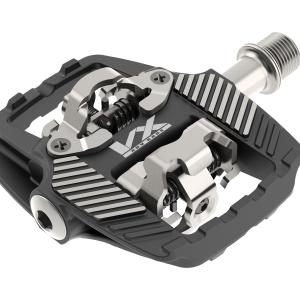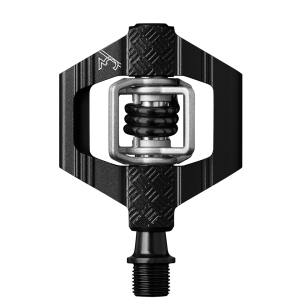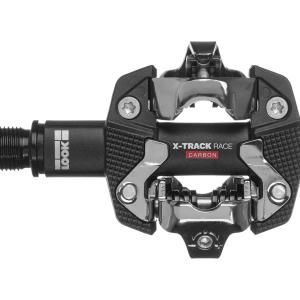HT Components T1 Clipless Pedals
(discontinued)
| Where To Buy | |||
|---|---|---|---|
Free shipping on orders over $50 (continental U.S. only).
International shipping available. Some exclusions apply. |
|||
Free shipping on orders over $50 (continental U.S. only).
International shipping available. Some exclusions apply. |
|||
Review and product photos by Brandon Turman // Action shot by Lear Miller
Just a few years ago HT Components stormed onto the flat pedal scene with some incredibly thin pedals that turned heads while simultaneously dropping precious grams off your steed. Then came HT's partnership with Aaron Gwin,during which time they developed the X1 and X2 - clipless pedals with large platforms designed to withstand the rigors of World Cup Downhill racing. A few months ago we spotted Brian Lopes racing the Sea Otter Dual Slalom with a lighter, slimmer pedal based around the same clipless mechanism. Only recently did HT break the news that they signed former Enduro World Series Champion, Jerome Clementz, who has been racing the production version of that Sea Otter prototype. They're calling the new pedal the T1, and we've been giving it a go for the better part of two months.

T1 Clipless Pedal Highlights
- Extruded CNC aluminum body
- CNC machined chromoly spindle
- New EVO+ needle bearing system and one DU bushing per pedal
- Two adjustable grip pins per side
- HT exclusive cleats with 4-degree (X1) or 8-degree (X1F) float and 13-degree release angle
- Weight: 368g per pair
- MSRP: $135 USD
So how do you take a downhill pedal design and adapt it to trail use? A slimmer body is a good place to start. The T1 body measures just 16.8mm thick at the center, and the platform is 68mm wide x 83.5mm long. That's quite a bit more compact than the X1 downhill pedal, though the T1 still offers a bit of a platform for some additional support or traction when you don't have time to clip back in, at least in theory.
Housed inside the body is HT's very own clipless mechanism. When creating the T1, HT took the opportunity to make a few updates here as well. If you look closely at the back of the clipless mechanism on each pedal in the photos below, you'll notice that the T1 has an angled plate at the back, versus the perpendicular plate on the X1. This update was made after receiving input about occasional difficulty clipping in and inconsistent entry. The cleat can now glide up and over the pedal rather than getting hung up.

Initial Impressions
Installing the pedals was as easy as you'd expect. There are no wrench flats, but there is an 8mm allen slot on the partially hollow axle. For those that like to ensure the pedals are snug the large allen size is a plus.
HT offers a few different cleats with varying amounts of float. If you prefer less wiggle, install a pair of the 4-degree X1 cleats, otherwise use the 8-degree X1F cleats. Cleat installation was made painless thanks to relatively square edges for easy reference during alignment, as well as plenty of side-to-side adjustment range. The cleat is held secure by several protruding dots that mash into your shoe sole as you tighten the bolts.

Plastic spacers are included to customize the amount of contact your shoe has with the pedal. We found that the relatively thick cleat required no spacers on both Specialized 2FO and Teva Pivot shoes. Others may need a spacer or two. With zero spacers installed the pedals had the greatest contact area with the shoes, the cleat was recessed just enough to prevent the annoying "clickity-clack" sound while walking, and it allowed us to take advantage of all that shoe tread while hiking.
We appreciate the nice wide body construction, relatively thin profile, great look, and ability to choose from 10 anodized colors. The metal axle end plug used to service the pedals is a great addition, as opposed to the plastic alternative that often gets stuck or stripped. Both axles spun smoothly out of the box with no perceivable play.

When you clip in, springs at the front and back of the pedal engage. The tension adjustment mechanism tightens the back of one side and the front of the other, ensuring an even feel on both sides. We found it to be simple, effective, and easy to access with both a standard 3mm allen key and a multi-tool. There are two indicators per pedal with several hash marks to help determine a consistent setting on both pedals. We did notice some slight inconsistencies in spring tension, however. With the tension indicators set to the same position all around, our left pedal felt noticeably tighter than the right, requiring us to back the tension off half a turn. With things evened up it was time to hit the trail.
On The Trail
The tension adjustment screw changes the feel from one like you're standing on ice to not-quite-twist-your-ankle-while-trying-to-release tight. Regardless of the setting, they make a loud "click" noise on entrance, confirming a solid connection and freeing your mind for what lies ahead on the trail. Unlike many other clipless designs, the clipless mechanism doesn't rotate around the axle, which means that with the pedal level you need to angle your toe downward slightly to hook the front end of the cleat before stomping down with your heel. Alternatively you can start further back and slide your foot forward over the top of the pedal and it will rotate as needed.
For the most part they are reliably easy to go in/out, whether you're rotating your foot toward or away from the bike. As you rotate your foot to release, you'll notice that it requires more and more force the further you rotate until it eventually unclips.

Our one big complaint is a result of side-to-side movement along the line of the axle. HT's pedals have a gently angled spring up front and straight one out back, and the part of the cleat that goes inside the pedal is quite a bit narrower than the inner width of the springs. Depending on which cleat you have installed, this allows nearly 1/4-inch of movement side-to-side, as shown in the animation above. For comparison, a worn out pair of Crankbrothers pedals allow about 1/8-inch movement, while Shimano's SPD system holds you securely in place. On the HT pedals this can be a little weird as the release feel varies depending on where the cleat is relative to the spring. If you're at the extreme end on the outside or inside of the pedal, you sometimes get a notchy two-stage release, but if you're centered it feels nice and clean. We've found the pedals work best with the X1 cleats installed at the tighter side of the adjustment range to help keep you centered.

The platform of the pedal is quite small, so while it doesn't do much to make your whole foot feel stable like a DH-sized platform, the width of the platform does add some side-to-side rotational stability, especially when paired with a skate-style clipless shoe. But what about those two traction pins? Well, without any spacers installed on both the Specialized 2FO and Teva Pivot shoes, the pins don't come anywhere close to touching the shoe. HT says Five Ten's Kestrel shoe works well, however. We noted that Jerome Clementz chooses to remove the front screws, likely for a more consistent entry. The back of the pedal does give some extra support when clipped in, depending on your shoes.

As far as riding out of the clips during those "oh-shit" moments is concerned, don't expect a whole lot of traction as the platform is rarely actually in contact with your shoe. Then again, what clipless pedals actually give traction when you aren't clipped in? In general the biggest benefit of a platform is additional stability when clipped.
In rocky terrain the beveled front edge helps the pedals glide over rocks rather than hanging up, as does the new angled adjustment plate. Performance in the mud isn't too shabby, as the mud tends to get smashed though the pedal and clears pretty easily.

Long Term Durability
Unlike other pedals there was very little break-in time and things have stayed consistent over a few months of use. The cleats are made from steel, and as a result they have worn very little. We've also noted that the tension adjustment stays in place, at least at the tighter end of the spectrum. You may read reports elsewhere of the adjustment screw stripping easily, but we haven't experienced the issue and HT has addressed this in recent production runs.
Many of HT's flat pedals tend to develop some play, but that hasn't been the case with the T1's improved EVO+ bearing system. The pedals still spin in a very smooth and controlled manner.
Noise wise, they developed a slight squeak/squeal while releasing after several dry and dusty rides, but cleaning them up and applying a little bit of chain lube helped resolve the issue.
We've bashed them into a number of rocks with good results. The body still looks great, they don't scratch very easily, and the clipless mechanism is holding up well.

What's The Bottom Line?
For clipless pedals to pass the test with flying colors, they must allow you to quickly get in and out on command, have a smooth and consistent feel, provide adequate stability, not pop out unexpectedly, resist rock strikes, and remain durable in the long term. HT's new T1 pedals meet most of these requirements, however the release feel can be inconsistent depending on foot placement, the cleats you're using, and the tension setting. The pedal needs to be run toward the tighter side of the adjustment range with the 4-degree X1 cleat for best results. As such we believe the pedals are best suited to experienced clipless users.
Beyond the release feel, it's easy to know when you're clipped in, they're visually awesome, come in a bunch of colors, have a slim profile, and have done very well in the long term.
Visit www.ht-components.com for more details.
About The Reviewer
Brandon Turman likes to pop off the little bonus lines on the sides of the trail, get aggressive when he's in tune with a bike, and to really mash on the pedals and open it up when pointed downhill. His perfect trail has a good mix of flow, tech, and balls-to-the-wall speed. He loves little transfers, rollers, and the occasional gap that gives him that momentary stomach in your throat kind of feeling. Toss in some rocky bits with the option to double over them or risk pinch flatting and you've got a winner in his book. In 14 years of riding he worked his way through the Collegiate downhill ranks to the Pro level. After finishing up his mechanical engineering degree, his riding focus turned to dirt sculpting and jumping with the occasional slopestyle contest thrown in for fun. Nowadays he's Vital MTB's resident product guy, putting in saddle time on nearly every new platform and innovation the bike industry has to offer.
Specifications
| Where To Buy | |||
|---|---|---|---|
Free shipping on orders over $50 (continental U.S. only).
International shipping available. Some exclusions apply. |
|||
Free shipping on orders over $50 (continental U.S. only).
International shipping available. Some exclusions apply. |
|||
























3 comments
Post a reply to: Tested: HT Components T1 Pedals